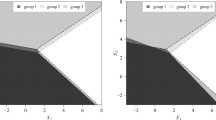Abstract
Linear discriminant analysis is a commonly used statistical tool for the classification of surface features using satellite surface reflectance data. Extensions of this basic tool promise substantial improvements. In particular, we examine the added effectiveness of the integration of spatial autocorrelation into the discriminant model, the resolution of nonhomogeneous pixels, and data based prior probability estimates of class membership.
Similar content being viewed by others
References
Kowalik, W. S., 1979, Personal communication.
Marsh, S. E., Switzer, P., Kowalik, W. S., and Lyon, R. J. P., 1980, A method for resolving the percentage of component terrains within single resolution elements. To appear in Photogrammatic Engineering and Remote Sensing.
Author information
Authors and Affiliations
Rights and permissions
About this article
Cite this article
Switzer, P. Extensions of linear discriminant analysis for statistical classification of remotely sensed satellite imagery. Mathematical Geology 12, 367–376 (1980). https://doi.org/10.1007/BF01029421
Received:
Revised:
Issue Date:
DOI: https://doi.org/10.1007/BF01029421




